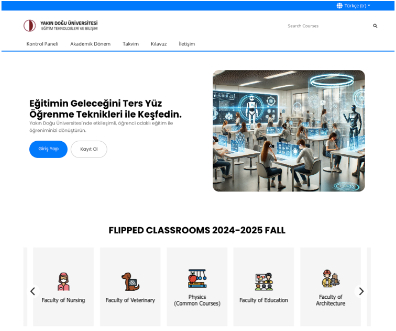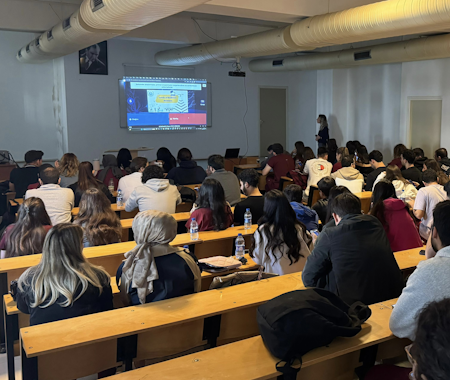In today’s world, where digitalization in education is rapidly spreading, traditional methods are being replaced by student-centered and innovative approaches. One of the most notable examples of these approaches is the Flipped Learning model. This model aims to enhance the effectiveness and efficiency of education by redefining the roles of students and teachers. Near East University implemented this pioneering model in the Fall semester of 2017 under the leadership of Vice Rector Prof. Dr. Mustafa Kurt and coordination by Educational Technologies Coordinator Assoc. Prof. Dr. Gülsüm Aşıksoy. Since then, it has been successfully applied in all faculties every academic term. As of the Fall semester of 2024-2025, 81 courses at our university are being conducted with this model.
Near East University will continue to take innovative steps in education by expanding the Flipped Learning model. The development of distance learning platforms, the production of more digital content, and data analysis focused on students’ individual learning experiences will further strengthen this model. Moreover, by collecting and analyzing educational data, we aim to gain a better understanding of students’ learning processes. In this context, the use of data mining and learning analytics methods in education will be strategically employed to increase the effectiveness of Flipped Learning practices. Students’ performance, participation, and interaction levels will be assessed through these analyses, and teaching processes will be optimized accordingly.
For more information about Near East University’s Flipped Learning model, you can visit the university’s official Flipped Learning page at flippedlearning.neu.edu.tr.

Flipped Learning Model
Flipped Learning is an innovative pedagogical approach that reverses the traditional teaching method, making education more dynamic and interactive. The core philosophy of this model is based on the principle that classroom time should be dedicated not to the transmission of information, but to students’ active participation in learning activities.
In this model, the educator prepares and shares lesson videos and documents with students prior to class, covering basic concepts that students can learn independently. Thus, students can engage in remembering and understanding level learning at their own pace and in their personal learning environments, guided by materials prepared by the educator. While watching the lesson videos at home, students can pause, slow down, or rewatch the content, take notes, and prepare questions on topics they don’t understand. This process enables students to come to class better prepared and saves the teacher time that would otherwise be spent on information transmission and repetition.
When students come to class, they work in groups with the guidance of the educator to reinforce what they have learned and clarify any points of confusion. In this process, classroom learning focuses on higher-order thinking skills such as application, analysis, evaluation, and creation. Discussions, problem-solving activities, and answering students’ own questions take place under the guidance of the teacher.
This approach encourages both active participation and collaborative learning within a social environment. The dynamic classroom setting prevents mental passivity and ensures that class time is used efficiently. Students share the knowledge they have gained with both their teachers and peers, creating a deep and meaningful learning experience.
The Flipped Learning process follows these steps:
- Before class, students study digital content and take notes. They identify points they don’t understand and prepare questions.
- Unclear topics are discussed in group activities during class.
- The educator forms groups based on students’ questions and needs and manages in-class learning activities.
- During group work, the educator guides the groups, providing support for deeper understanding.
- At the end of the class, the educator asks questions to reinforce the learned knowledge through practical application.
- This model transforms students from passive receivers of knowledge into individuals who actively acquire, apply, and develop knowledge.
How to Design an Effective Flipped Learning Course?
The effective implementation of the Flipped Learning model depends on the careful planning of lesson content and learning processes. The success of this model is achieved through students’ individual preparation before class and reinforcement of learning during in-class interactions. Key points for designing an effective Flipped Learning course include:
- Preparing Lesson Content: In Flipped Learning, students should be well-prepared on the topic before the lesson. Therefore, it is crucial for educators to prepare clear and comprehensive content that allows students to learn at their own pace. Various materials such as videos, articles, e-learning modules, or infographics can be used. Ensuring that the content is understandable and accessible helps students grasp the fundamentals in advance.
- Encouraging Individual Preparation: The main goal of this model is for students to come to class prepared. Therefore, students should be encouraged to review the pre-class materials. Educators can motivate students to watch videos or read articles beforehand and prepare questions. This enables students to come to class thinking about topics they don’t understand, fostering active participation.
- In-Class Activities and Active Participation: The most important element of Flipped Learning is in-class interaction. Students actively participate in class with the knowledge they have prepared in advance. Educators can engage students in group work, discussions, or problem-solving activities, making learning more permanent. This process encourages students to learn from each other through group work.
- The Role of the Educator as a Guide: In the Flipped Learning model, the educator is not a transmitter of knowledge but a guide who directs the learning process. While students are actively working in class, the educator observes them and intervenes when necessary, providing guidance to enhance the learning process. The educator directs according to the needs of each student, allowing them to learn at their own pace.
- Feedback and Evaluation: In Flipped Learning, it is essential to assess students’ learning progress and provide feedback. Assessing how much knowledge students have gained through in-class activities and individual work is valuable for enhancing the effectiveness of the model. Educators can track students’ progress through quizzes or questions and adjust the course flow accordingly.
- Effective Use of Technology: Technological tools are an indispensable part of Flipped Learning. Providing students with digital materials and online access to these materials facilitates the learning process. Furthermore, using digital platforms to track and evaluate students’ pre-class work enhances the effectiveness of the model.
- Continuous Updating and Improvement: Flipped Learning is a dynamic model that requires constant improvement. Educators should regularly review lesson content and in-class activities and update lesson materials based on student feedback. This ensures that the learning process remains up-to-date and effective.

In-Class Activity Snapshot of a Physics Course Conducted with Flipped Learning
Advantages of the Flipped Learning Model
The Flipped Learning model offers various advantages that make educational processes more effective and accessible. Here are some of these advantages:
Student-Centered Approach: Flipped Learning allows students to direct their learning processes at their own pace. In this model, students acquire theoretical knowledge before class and participate more actively in classroom activities.
Increased Participation: Classroom activities significantly increase student participation. Students actively engage with the knowledge, contributing to discussions and group work.
Interactive Environment: Educators have more opportunities to interact with students during class. This provides an important advantage for students to get answers to their questions and learn in-depth.
Flexible Time Management: Students gain more flexibility in accessing lesson materials. This allows them to organize their studies more comfortably according to their busy schedules.
Customized Materials: Flipped Learning offers the opportunity to provide students with customized content tailored to different learning styles. This helps each student have a learning experience that suits their needs.
Enhanced Critical Thinking Skills: Discussions and problem-solving activities conducted in the classroom allow students to develop their critical thinking skills.
Practical Application Opportunities: Especially in fields where practical skills are critical, students have the chance to reinforce their knowledge through practical applications after learning theoretical information.
Instant Feedback: Educators have the opportunity to provide instant feedback to students through in-class interactions, which accelerates the learning process.
Control of the Learning Process: Students have the authority to manage their own learning processes. This increases their motivation and helps them develop independent learning skills.

In-Class Application of a Dentistry Course with Flipped Learning
Near East University’s Flipped Learning model, which has been successfully implemented for years, expands the boundaries of education while providing students with the opportunity to discover, apply, and develop knowledge. Thanks to Flipped Learning, every student can learn at their own pace and develop critical thinking, problem-solving, and creative collaboration skills in the classroom. The opportunities provided by digitalization in education and the innovative structure of Flipped Learning offer a strong foundation to prepare our students for the world of the future. As Near East University, we continue to advance with this model to enhance quality and accessibility in education.